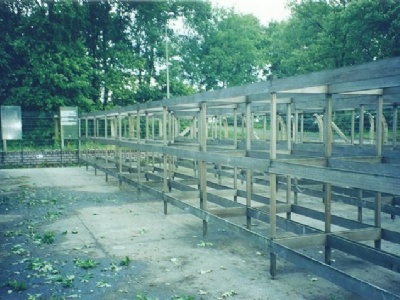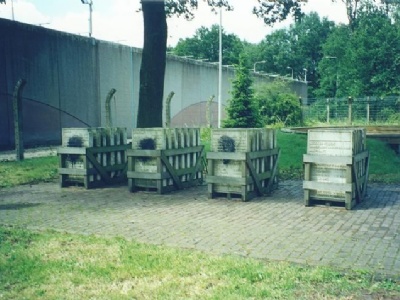Vught
Kamp Vught or Kamp Herzogenbusch existed between January 1943 and September 1944 and was divided into two sections. One section was called the JDL – Judendurchlager (Jews transit camp). Jews gathered by the Gestapo were sent here during razzias where Jews forced to move out from their homes or hideouts. At a later date, these Jews were deported to Westerbork and then on to Auschwitz or Sobibor in Poland. Only two transports went directly to Poland from Vught. About 12,000 Jews were sent via Vught to Westerbork and later to Poland where they were murdered.
The Second section was a ordinary prison, Schutzhaftlager, with mainly Dutch and Belgian prisoners. In May 1943, the camp was expanded with a section for female prisoners (Frauenlager). A section for political prisoners was also built in August waiting to be transported to another prison or camp. This section was called Polizeiliches Durchganglager. Vught had his own crematorium and special execution place for prisoners sentenced to death. When the camp was liberated by Canadian forces, the camp was already evacuated.
In January 1944, camp commander Adam Grünewald locked a female prisoner in a cell. Other female prisoners began to protest against this and as punishment the commandant ordered as many females as possible to be locked into the cell. A total of 74 women were locked in on an area of just 9 square meters with hardly any ventilation. When the cell was opened 14 hours later, 14 women had died as a result of lack of oxygen. When this incident came out through rumour spreading and was published in illegal resistance newspapers, the local Nazi leadership was displeased. They degraded Grünewald to a common soldier and sent him to the eastern front where he was killed in battle 1945.
Such legal action for commanders and other guard personell was isolated events and should not be interpreted as the Nazis being concerned about the prisoners’ own good. On the contrary, it was the case that the arbitrary use of force by commanders and guard personnel passed unnoticed without any legal action being taken. But in this case, the local nazi leadership felt that the incident hurt the Nazi’s and therefore felt compelled to take action. The fact that the camp was a transit camp for Jews to be murdered was obviously something completely different.
More than 30,000 people went through the camp during its existence. About 700 prisoners were executed in the camp between 1943 and 1944, and about 15,000 Jews were later murdered in Auschwitz or Sobibor. As allied forces approached, Vught was evacuated between July and September 1944. The remaining 3500 prisoners were sent to Sachsenhausen and Ravensbrück and the camp was handed over to the Red Cross on 22 September 1944.
Current status: Partly preserved/demolished with museum (2000).
Address: Lunettenlaan 600, 5263 Vught.
Get there: Car.
Follow up in books: Gilbert, Martin: The Holocaust: A History of the Jews of Europe During the Second World War (1987).







_400x300.jpg)
The Museum is very small as it only covers a small fraction of the former camp area. There are also watchtowers left but these are low so one might think why so. This is because right next to the museum is Holland’s most guarded prison. Therefore, the museum had to make a compromise with the prison management that the watchtowers should not be higher than the prison wall. Therefore they can not be used as lookout posts for any escape attempts or mapping of the prison from the outside.